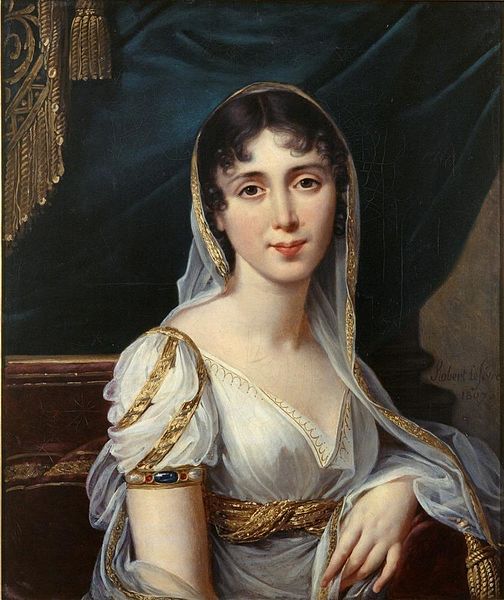Article made by Eleonor Nolan.
May 20, 2020.
Storyline:

Let’s position ourselves a few years after the French Revolution. Royalty had been banished. There are constants riots. In one of these episodes the protagonist’s brother, Etienne Clary, was arrested by mistake. Due to this, his wife and younger sister (who is, of course, Désirée herself) go to the town hall to request for his release to the corresponding authority; that is to say, a man who strikes fear for his rigor but who can well agree to their demand.
Bernardine Eugénie Désireé, a young woman of just fourteen years old, a little clueless child, falls asleep in the town hall while she waits, and wakes up after several hours.
Everything is dark. There is no one anywhere who can guide her. Have they forgotten her? Where are their brother and sister-in-law? But wait, there is a young man… A young man named Bonaparte.
This gentleman accompanies the girl to her house.
“It’s not pleasant for a young lady to walk through the city alone at this time of night.”
(Désirée, Annemarie Selinko. The Reprint Society’s editions, 1954; page 26)
“It is too kind of you, Monsieur, but I cannot accept-” I sammered in embarrassment. “You said yourself that you wanted to go home.”
He laughed: “A friend of Robespierre permits no contradiction. We’ll have a sweetmeat each, and then go.”
As they walk the streets of Marseilles, Desirée tells him that he should make her a visit the next day; also she asks him to attend together with one of his brothers assuring that they will spend an adorable afternoon in the company of Julie and hers.
“Julie? So far I have only heard about Suzanne and Entienne, not Julie. Who is Julie?
(Désirée, Annemarie Selinko. The Reprint Society’s editions, 1954; page 29)
(…)”Julie is my sister,” I said.
“Older or younger?” He sounded keenly interested.
“Older. She is eighteen.”
“And-pretty?”
“Very pretty.”
(…)“You swar it?”
“She has lovely brown eyes,” I declared, and so she has.
As a result of this, Joseph Bonaparte, who will later marry Julie Clary, and Napoleón Bonaparte enter into their lives.
Désirée was Napoleón’s first fiancée. They got engaged on the eve of Joseph and Julia’s wedding. The Napoleón we’ll meet in these brief moments is a much simpler man than the one we’ll see later. In those years he was a General without much pomp; in other words, nobody knew him but his own family and, of course, the members of the military circle in which he operated. When he got engaged to Désireé she was still fourteen years old, while he was twenty-five. But the marriage did not take place immediately due to a promise he made to Désireé’s mother. He will wait until she was sixteen to take her as his wife.
Time passed and Napoleón left Marseille with the intention of realizing his own plans and ambitions. For two years he didn’t see his fiancée at not family or social gathering at all; although they maintained communication through an infinite number of letters. Their relationship would find an end when Désirée, having fled without anyone noticing so as not to lose her fiancé’s love, would become a witness in a room full of people of his marriage proposal to another woman. For a brief moment, on that fateful night, they would face each other. In his eyes she would only see indifference and fury.
“… Do you believe in me, Eugenie? Do you believe in me, whatever happens?”
(Désirée, Annemarie Selinko. The Reprint Society’s editions, 1954; page 44)
His face was quite close to mine, so close that I trembled and involuntarily closed my eyes. Then I felt his lips pressed tightly on mine, untile suddenly -I don’t know how it happend, it was certainly not what I meant to do- my lips parted.
‘You’ll believe in me whatever happens, won’t you?’ Napoleon asked me once (…) Of course, I thought, I understand you, Napoleon, I do. But it’ll break me…
(Désirée, Annemarie Selinko. The Reprint Society’s editions, 1954; page 88)
From then on, the Seine River, would witness Désirée’s agony, worries and fears
We got out, went side by side to the middle of the bridge leaned over the edge. The thousand lights of Paris were dancing up and down on the waves of the river.
(Désirée, Annemarie Selinko. The Reprint Society’s editions, 1954; page 124)
Years later, Désirée would marry Jean Baptiste Bernadotte; a man fifteen years older than her who would become Bonaparte’s rival in the sentimental and political instances that were to come.
Over twenty years, Désirée and Napoleón would meet again and again. Some of these occasions alone; intimately alone, with a dangerous closeness; maybe much more for her.
“If I may be so bold as to make a request I should be most grateful to Your Majesty if we could go to Box 17.”
(Désirée, Annemarie Selinko. The Reprint Society’s editions, 1954; page 229)
He did not trust his ears. Bending forward he raised his eyebrows and repeated: “Box 17?”
I nodded.
Napoleon looked round the stage. Josephine was making conversation with a number of ladies, Joseph appeared to be haranguing Talleyrand, and his bad-tempered-looking brother Louis, and the Marshals were distributed on the dancing floor. His eyes narrowed and began to flutter. “Is it proper, little Eugenie?”
Yes, a closeness sometimes unintended and others expected with an anxiety camouflaged behind good manners and etiquette. A proximity that would also burn him inside.
“A pity you are married to Bernadotte,” he said.
(Désirée, Annemarie Selinko. The Reprint Society’s editions, 1954; page 402)
Quickly I felt my way back to the door.
He called out. “Eugénie!”
But I had reached his brigthly lit big study.
Structure of the novel:
The facts are revealed to us through the writings established by Désirée herself in a blank notebook that her father gave her to write her memories as a citizen of a country that he thought it had achieved its consolidation as a republic in the name of the phrase “liberty, equality and fraternity” that come out of the revolution.
Then, the novel is narrated in the first person of the singular. Throughout the reading we learn about different events such as the birth of his son Oscar who was Napoleón’s godson at his request.
The writing is simple and sometimes plays with the sequence in which the events have happened.
The excuse to relate certain events is to focus on Désirée’s feelings at different stages of her life; already in the first years of youth, already in adulthood, already in old age. Love, spite, jealousy, and insecurity are present throughout the narration in circumstances where she had been ignored and underrated.
Characters analysis:
About the characters, it is interesting to highlight some of them such as:
▪Jean Baptiste Bernadotte
Jean Baptiste Bernadotte is a man of strong character but at the same time affectionate with his wife and son; he would have Désirée’s companionship until the day he died.
French by birth, Jean Baptiste Bernadotte was a Republican and, probably, the tattoo found on his body after his death dated from the time of the French Revolution (this information is not revealed in the novel). It said “Death to the kings”[i]. This fact is curious considering that Jean Baptiste was king of Sweden and Norway under the name of Karl XIV Johan. Jean Baptiste Bernadotte also appears as a figure opposed to Napoleón in all aspects, especially concerning ethics and moral principles.
▪Julie Clary
Another character to highlight is Julie Clary. Désirée’s older sister is introduced at the beginning of the narration as an eighteen-year-old woman who has a certain control over the youngest of the family, due to the freedom and privileges that four years of experience brings to her. She is somewhat dismissive, capricious, and constantly in a bad temper. As the years go by, we notice that Désirée gains self-control over her own emotions which positions her in a higher place than Julie, who, instead, occupies the role of fragile and insecure woman in need of constant help from her husband, Joseph Bonaparte, and young Désirée.
▪Joseph Bonaparte
The personality of Joseph is also attractive. In his first appearances he gives the impression of being a self-assured subject; however, we can see later that he shares the same character as his wife and that he shields himself with Napoleón’s reputation to hide his hesitations and obtain favors on behalf of his brother’s name. Joseph is deeply convinced that Napoleón’s fate overshadowed what might have been his own. On the other hand, in his relationship with his wife, he occupies in some way the place he would have wanted to represent in life. Julie appears as a woman in love with her husband and supports him in the name of that love, leaving aside her wishes to follow the path he traces for both of them.
▪Lucien Bonaparte
Another of the Bonaparte brothers who stands out for himself is Lucien. He is an honest, judicious young man. Like Bernadotte, he is a defender of the structural principles of the Republic. He also has a great oratory capacity. He played a fundamental role when it came to positioning Napoleón as first Consul. However, later he would face his elder brother due to his eccentricities.
▪Laetitia Bonaparte
The Bonaparte’s mother, Laetitia, shows up with two different characterization in the story. During the first years of her elder son’s military career, she was nothing more than a woman belonging to a poor social stratum; she was a coarse madam but extremely concerned about the well-being of her children. After Napoleón’s political success, she is presented, instead, as an old lady of lineage, dressed in furs and jewels, with manners somewhat more refined by her dealings with royalty.
▪Joséphine de Beauharnais
Joséphine de Beauharnais, the first wife of Napoleón, is a woman, unlike Laetitia, who has always belonged to the upper Parisian sphere; although with constant debts that would be settled during her second marriage. Arrogant, sarcastic, she had a certain kindness and appreciation for her family similar to that Laeticia had towards her family.
▪Hortense de Beauharnais
Regarding Hortense, Joséphine’s eldest daughter, we also find opposite behaviors throughout the narrative. First, we observ a fourteen-year-old girl, unsure of herself, and submissive; at the same time, secretly in love with her stepfather. Then, we notice that she adopts a stately and superior air when Napoleón becomes Emperor.
▪Marie (last name: unknown)
Finally we have the presence of Marie, the woman who raised Désirée. She was a second mother to her. Later on, she would also be the one to help Désirée raise her son during the child’s first years of life. Marie became Désirée’s confidant during her romance with Bonaparte. She gave to Désirée a gold medallion as a gift in order to have money to return from Paris when the girl ran away from home. Her character is strong but at the same time shows a sensitivity that makes her empathize with Désirée. This is why the little Clary becomes the only member of the family who Marie really appreciates.
Physical space:
The narration unfolds through the first chapters in the house where Désirée lived her childhood; a small house in Marseille. This house must have left strong impressions in the girl’s memory so that in the course of the story only those spaces of similar dimensions, or capable of evoking the sensations that she experienced in that home, come to take precedence. In that way, we can take into account the descriptions of the first two houses in which Désirée lived with her husband in detriment of the palaces where she occasionally had to spend part of her days. Although in the narration there is no clear exposition of one or the other, the reader intuits that the protagonist can only feel comforted in those little nooks and niches.
Curiosities:
Napoleón’s facial features, as well as his body posture, has an special importance in the novel. In the brief moments that both of them share after breaking their engagement, we find an exhaustive list of tiny details that would be irrelevant to anyone. Striking is this ability of Désirée to remember each fragment of Napoleon’s face in contrast to hers difficulty in giving the reader a similar description regarding the physiognomy of her husband whom she deeply loves.
This skill also encompasses everything that surrounds Napoleón. It is possible to collect more information about the manners and gestures of the family of her former fiancé than of her own. The same happens when making a comparison between the descriptions of the enclosures of the Palace of Versailles, where she would meet with Napoleón more than once, and the residences where her entire life would be spent (despite the affective value for which those would stand out).
[i] ↑ www.napoleon.org: “BERNADOTTE, Jean-Baptiste-Jules (1763-1844), maréchal, roi de Suède et de Norvège”



Interesting article!!!